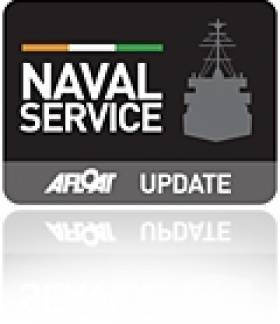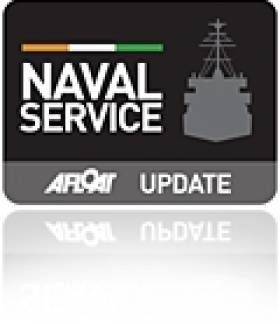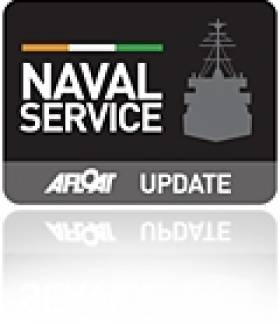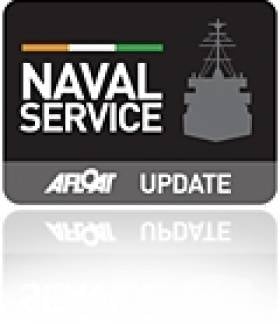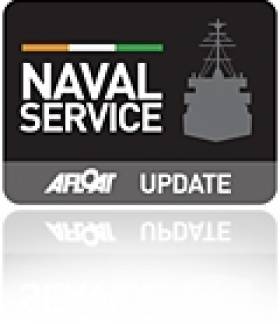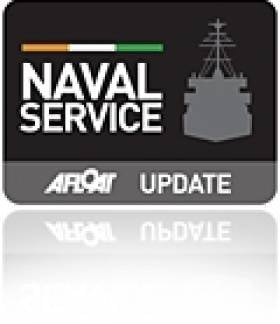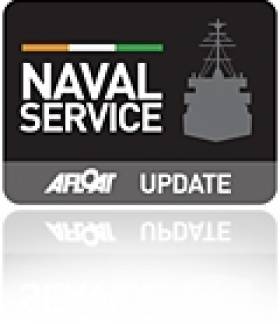Displaying items by tag: Fishery Detention
#FisheryDetention – The day after the Naval Service's newest OPV90 class L.E. Samuel Beckett arrived at Haulbowline, the navy's second oldest unit, the 2001 built L.É. Niamh detained a Spanish registered fishing vessel, writes Jehan Ashmore.
L.É. Niamh carried out the detention 100 nautical miles south of Union Hall, the detention was in regards of an alleged breach of fishing regulations. The OPV80 class sister, the leadship L.E. Roisin also detained a Spanish fishing vessel almost a fortnight ago.
The newbuilds likewise of their pair of OPV 80 predecessors, the leadship 'Roisin' class are based from this design and that by STX Canada. However, the north Devon shipyard that built the Roisin sisters were then completed by Appledore Shipbuilders and which would later go into administration and where Babcock Marine took over in 2003.
According to the Naval Service, today's detained fishing vessel was escorted by L.É Niamh to Castletownbere, Co Cork and handed over to An Gardaí Síochána.
In total this year there were 169 vessels boarded by the Naval Service, 17 warnings issued and this latest detention is the fourth fishing vessel detained so far this year.
Spanish Fishing Vessel Detained off Mizen Head
#TrawlerDetained – LÉ Roisin (P51) a Naval Service OPV detained a Spanish registered fishing vessel last week for alleged breaches of fishing regulations.
The fishing vessel was detained approximately 100 nautical miles south-west of Mizen Head and headed to Castletownbere, Co.Cork at the weekend and from where she was handed over to the Gardaí.
So far this year, the Naval Service have carried out 250 boardings and 17 warnings issued, and with the Spanish vessel becoming the third vessel detained for alleged infringements of fisheries regulations also in 2014.
Navy Detain Irish Trawler off Waterford Coast
#DetainedTrawler – The Naval Service's CPV LÉ Ciara (P42) detained an Irish registered fishing vessel last week in an area approximately 20 nautical miles off the south Waterford coast.
The vessel was detained for an alleged breach of fishing regulations. This is the twelfth detention made by the Naval Service this year following 901 boardings.
The fishing vessel hauled its nets and was escorted by the LÉ Ciara to Cobh and was handed over to the Gardaí.
Irish-Registered Trawler Detained by Navy off Hook Head
#TrawlerDetained – According to The Irish Times, the Naval Service CPV LÉ Orla (P41) detained an Irish-registered fishing vessel yesterday about 50 nautical miles off Hook Head, Co Wexford.
The detention was in relation to an alleged breach of fishing regulations. The vessel was escorted last evening by the LE Orla to Dunmore East, Co Waterford and handed over to the Garda for further investigation.
This latest detention brings to 507 the total number of vessels boarded by the Naval Service in 2013, with 713 warnings issued and is the 6th vessel detained by the navy so far this year.
Navy Detain French Fishing Boat off Kerry Coast
#FisheryDetention - Naval Service OPV LE Niamh (P52) has detained a French fishing boat about 30 nautical miles off the coast of Valentia, Co Kerry, reports the Irish Examiner.
The fishing vessel was detained for an alleged under-recording of catch and is to be escorted to Castletownbere, where it is expected to arrive this morning and then handed over to the Gardaí.
Fishing Vessel Detained off South-East Coast
#NAVY– The Naval Service has detained a fishing vessel off the south-east coast over alleged breaches of fishing regulations, reports the Irish Examiner.
The L.E. Emer (P21) detained the Irish-registered boat around 19 nautical miles from Mine Head in Co Waterford yesterday evening.
The vessel was escorted to Cork and handed over to Gardaí in the early hours of this morning. More than 1,200 boardings and 17 vessels have been detained by the navy so far this year.
French Registered Vessel Detained off Castletownbere
#FISHERY DETENTION – A French registered fishing vessel, was detained by the Naval Service OPV L.É. Roisin (P51) approximately 170 nautical miles West of Castletownbere, Co. Cork last night.
The detention was in relation to alleged breaches of technical fishing regulations. The detained vessel was to be escorted by the offshore patrol vessel to Cork, and then transferred to the Gardaí.
Last week the navy detained an Irish registered vessel on the same grounds and also for alleged under-recording of catch, in waters 60 miles off Roches Point, as previously reported on Afloat.ie
This latest detention by the Naval Service raises the number to 16 vessels so far in 2012.
Navy Detain Irish Trawler off Ballycotton
#NAVAL SERVICE –An Irish registered trawler was detained by the Naval Service OPV L.É. Niamh (P52) some 50 nautical miles south of Ballycotton, Co. Cork in the early hours of yesterday morning.
The detention was in relation to alleged breaches of technical fishing regulations. The trawler was taken under escort by the OPV to Cork and was to be handed over to the Gardaí.
So far the Naval Service in 2012 have carried out 1006 boardings, issued 38 warnings and detained 13 vessels.
Navy Escort Detained Trawler to Castletownbere
Less then a month ago the Naval Service detained a Northern Irish registered fishing vessel the Lynn Marie seven miles east off Bray Head. Onboard was a crew of 4 UK nationals who were taken into custody to the Gardai after the trawler was escorted by the CPV L.E. Orla to Dun Laoghaire Harbour. To read more about this detention click here.
Ironically the L.E. Orla was a former Royal Naval vessel, HMS Swift (P241) which was deployed on her first assignment to the Hong Kong Patrol Squadron for a four-year period. In 1988 Margaret Thatcher's Conservative Party Government disposed HMS Swift and HMS Swallow (P242) to the Irish Naval Service. The pair were built by Hall Russell Shipyard of Aberdeen as part of an eight 'Peacock' class coastal patrol vessel (CPV).
The 'Peacock' pair were commissioned into the Naval Service and renamed L.E. Orla (P41) and L.E. Ciara (P42) in a ceremony attended by An Taoiseach Charles J. Haughey at the Naval Base in Haulbowline, Cork Harbour.
This weeks' detention is the second conducted by the Naval Service in 2011. Last year the Naval Service carried out 1,666 vessel boardings which resulted in 70 warnings and eight detentions.
- Irish Naval Service
- Cork Harbour
- Northern Ireland
- Haulbowline
- castletownbere
- naval service
- LE Niamh
- Royal Navy
- Ports and Shipping News
- Lynn Marie
- Fishery Breaches
- Fishery Detention
- Fishing Trawler
- Peacock Class
- Hong Kong
- Hall Russell
- Appledore Shipbuilders
- LE Orla
- HMS Swift
- LE Ciara
- HMS Swallow
- Margaret Thatcher
- Conservative Party
- An Taoiseach
- Charles J. Haughey
- Naval Base


























